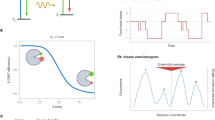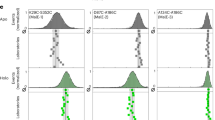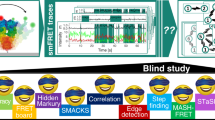Abstract
Förster resonance energy transfer (FRET) has been widely used in biological and biomedical research because it can determine molecule or particle interactions within a range of 1–10 nm. The sensitivity and efficiency of FRET strongly depend on the distance between the FRET donor and acceptor. Historically, FRET assays have been used to quantitatively deduce molecular distances. However, another major potential application of the FRET assay has not been fully exploited, that is, the use of FRET signals to quantitatively describe molecular interactive events. In this review, we discuss the use of quantitative FRET assays for the determination of biochemical parameters, such as the protein interaction dissociation constant (Kd), enzymatic velocity (kcat) and Km. We also describe fluorescent microscopy-based quantitative FRET assays for protein interaction affinity determination in cells as well as fluorimeter-based quantitative FRET assays for protein interaction and enzymatic parameter determination in solution.
Similar content being viewed by others
Log in or create a free account to read this content
Gain free access to this article, as well as selected content from this journal and more on nature.com
or
References
Steinberg IZ . Long–range nonradiative transfer of electronic excitation energy in proteins and polypeptides. Annu Rev Biochem 1971; 40: 83–114.
Stryer L . Fluorescence energy transfer as a spectroscopic ruler. Annu Rev Biochem 1978; 47: 819–46.
Giepmans BN, Adams SR, Ellisman MH, Tsien RY . The fluorescent toolbox for assessing protein location and function. Science 2006; 312: 217–24.
Li IT, Pham E, Truong K . Protein biosensors based on the principle of fluorescence resonance energy transfer for monitoring cellular dynamics. Biotechnol Lett 2006; 28: 1971–82.
Wu P, Brand L . Resonance energy transfer: methods and applications. Anal Biochem 1994; 218: 1–13.
Hillisch A, Lorenz M, Diekmann S . Recent advances in FRET: distance determination in protein–DNA complexes. Curr Opin Struct Biol 2001; 11: 201–7.
Miyawaki A . Development of probes for cellular functions using fluorescent proteins and fluorescence resonance energy transfer. Annu Rev Biochem 2011; 80: 357–73.
Grecco HE, Verveer PJ . FRET in cell biology: still shining in the age of super–resolution? Chemphyschem 2011; 12: 484–90.
Jares–Erijman EA, Jovin TM . FRET imaging. Nat Biotechnol 2003; 21: 1387–95.
Gordon GW, Berry G, Liang XH, Levine B, Herman B . Quantitative fluorescence resonance energy transfer measurements using fluorescence microscopy. Biophys J 1998; 74: 2702–13.
Ruiz–Velasco V, Ikeda SR . Functional expression and FRET analysis of green fluorescent proteins fused to G–protein subunits in rat sympathetic neurons. J Physiol 2001; 537: 679–92.
Wallrabe H, Elangovan M, Burchard A, Periasamy A, Barroso M . Confocal FRET microscopy to measure clustering of ligand–receptor complexes in endocytic membranes. Biophys J 2003; 85: 559–71.
Wallrabe H, Periasamy A . Imaging protein molecules using FRET and FLIM microscopy. Curr Opin Biotechnol 2005; 16: 19–27.
Horton RA, Strachan EA, Vogel KW, Riddle SM . A substrate for deubiquitinating enzymes based on time–resolved fluorescence resonance energy transfer between terbium and yellow fluorescent protein. Anal Biochem 2007; 360: 138–43.
Erickson MG, Alseikhan BA, Peterson BZ, Yue DT . Preassociation of calmodulin with voltage–gated Ca2+ channels revealed by FRET in single living cells. Neuron 2001; 31: 973–85.
Erickson MG, Liang H, Mori MX, Yue DT . FRET two–hybrid mapping reveals function and location of L–type Ca2+ channel CaM preassociation. Neuron 2003; 39: 97–107.
Raicu V, Jansma DB, Miller RJ, Friesen JD . Protein interaction quantified in vivo by spectrally resolved fluorescence resonance energy transfer. Biochem J 2005; 385: 265–77.
Chen H, Puhl HL 3rd, Ikeda SR . Estimating protein–protein interaction affinity in living cells using quantitative Forster resonance energy transfer measurements. J Biomed Opt 2007; 12: 054011.
Mehta K, Hoppe AD, Kainkaryam R, Woolf PJ, Linderman JJ . A computational approach to inferring cellular protein–binding affinities from quantitative fluorescence resonance energy transfer imaging. Proteomics 2009; 9: 5371–83.
Berney C, Danuser G . FRET or no FRET: a quantitative comparison. Biophys J 2003; 84: 3992–4010.
Martin SF, Tatham MH, Hay RT, Samuel ID . Quantitative analysis of multi–protein interactions using FRET: application to the SUMO pathway. Protein Sci 2008; 17: 777–84.
Zhong W . Nanomaterials in fluorescence–based biosensing. Anal Bioanal Chem 2009; 394: 47–59.
Grigsby CL, Ho YP, Leong KW . Understanding nonviral nucleic acid delivery with quantum dot–FRET nanosensors. Nanomedicine (Lond) 2012; 7: 565–77.
Medintz IL, Mattoussi H . Quantum dot–based resonance energy transfer and its growing application in biology. Phys Chem Chem Phys 2009; 11: 17–45.
Hu LA, Zhou T, Hamman BD, Liu Q . A homogeneous G protein–coupled receptor ligand binding assay based on time–resolved fluorescence resonance energy transfer. Assay Drug Dev Technol 2008; 6: 543–50.
Lebakken CS, Riddle SM, Singh U, Frazee WJ, Eliason HC, Gao Y, et al. Development and applications of a broad–coverage, TR–FRET–based kinase binding assay platform. J Biomol Screen 2009; 14: 924–35.
Kim B, Tarchevskaya SS, Eggel A, Vogel M, Jardetzky TS . A time–resolved fluorescence resonance energy transfer assay suitable for high–throughput screening for inhibitors of immunoglobulin E–receptor interactions. Anal Biochem 2012; 431: 84–9.
Song Y, Madahar V, Liao J . Development of FRET assay into quantitative and high–throughput screening technology platforms for protein–protein interactions. Ann Biomed Eng 2011; 39: 1224–34.
Nguyen AW, Daugherty PS . Evolutionary optimization of fluorescent proteins for intracellular FRET. Nat Biotechnol 2005; 23: 355–60.
Tatham MH, Chen Y, Hay RT . Role of two residues proximal to the active site of Ubc9 in substrate recognition by the Ubc9.SUMO–1 thiolester complex. Biochemistry 2003; 42: 3168–79.
Liu Y, Song Y, Madahar V, Liao J . Quantitative Forster resonance energy transfer analysis for kinetic determinations of SUMO–specific protease. Anal Biochem 2012; 422: 14–21.
Shen L, Tatham MH, Dong C, Zagórska A, Naismith JH, Hay RT . SUMO protease SENP1 induces isomerization of the scissile peptide bond. Nat Struct Mol Biol 2006; 13: 1069–77.
Author information
Authors and Affiliations
Corresponding author
Rights and permissions
About this article
Cite this article
Liao, Jy., Song, Y. & Liu, Y. A new trend to determine biochemical parameters by quantitative FRET assays. Acta Pharmacol Sin 36, 1408–1415 (2015). https://doi.org/10.1038/aps.2015.82
Received:
Accepted:
Published:
Issue date:
DOI: https://doi.org/10.1038/aps.2015.82
Keywords
This article is cited by
-
Develop quantitative FRET (qFRET) technology as a high-throughput universal assay platform for basic quantitative biomedical and translational research and development
Med-X (2023)
-
Live imaging of apoptotic signaling flow using tunable combinatorial FRET-based bioprobes for cell population analysis of caspase cascades
Scientific Reports (2022)
-
An in vitro Förster resonance energy transfer-based high-throughput screening assay identifies inhibitors of SUMOylation E2 Ubc9
Acta Pharmacologica Sinica (2020)
-
Advanced FRET normalization allows quantitative analysis of protein interactions including stoichiometries and relative affinities in living cells
Scientific Reports (2019)
-
Protein–Protein Affinity Determination by Quantitative FRET Quenching
Scientific Reports (2019)



